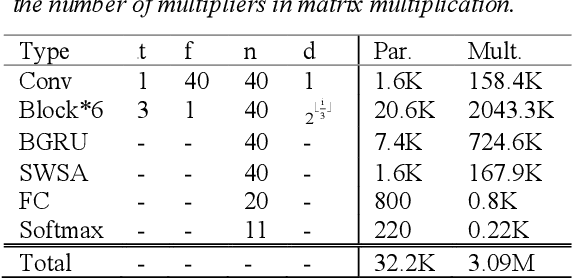Lidong Yang
A Separable Temporal Convolution Neural Network with Attention for Small-Footprint Keyword Spotting
Sep 01, 2021



Abstract:Keyword spotting (KWS) on mobile devices generally requires a small memory footprint. However, most current models still maintain a large number of parameters in order to ensure good performance. To solve this problem, this paper proposes a separable temporal convolution neural network with attention, it has a small number of parameters. Through the time convolution combined with attention mechanism, a small number of parameters model (32.2K) is implemented while maintaining high performance. The proposed model achieves 95.7% accuracy on the Google Speech Commands dataset, which is close to the performance of Res15(239K), the state-of-the-art model in KWS at present.
Magnetic Navigation of a Rotating Colloidal Swarm Using Ultrasound Images
Sep 18, 2018



Abstract:Microrobots are considered as promising tools for biomedical applications. However, the imaging of them becomes challenges in order to be further applied on in vivo environments. Here we report the magnetic navigation of a paramagnetic nanoparticle based swarm using ultrasound images. The swarm can be generated using simple rotating magnetic fields, resulting in a region containing particles with a high area density. Ultrasound images of the swarm shows a periodic changing of imaging contrast. The reason for such dynamic contrast has been analyzed and experimental results are presented. Moreover, this swarm exhibits enhanced ultrasound imaging in comparison to that formed by individual nanoparticles with a low area density, and the relationship between imaging contrast and area density is testified. Furthermore, the microrobotic swarm can be navigated near a solid surface at different velocities, and the imaging contrast show negligible changes. This method allows us to localize and navigate a microrobotic swarm with enhanced ultrasound imaging indicating a promising approach for imaging of microrobots.
 Add to Chrome
Add to Chrome Add to Firefox
Add to Firefox Add to Edge
Add to Edge